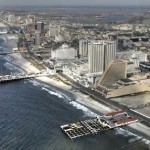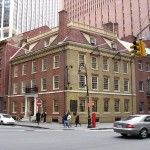Imagine owning this beachfront property at one time in your life. This is Atlantic City, New Jersey. Donald Trump owns a piece of it. Pieter Wulfertsen, owned a large chunk of turf in the neighborhood long before casinos opened on the Boardwalk. He also owned and operated a business in the heart of the Financial District (Wall Street) on Manhattan. Pieter Wulfertsen’s home was in the neighborhood of the World Trade Center. Pieter was born in 1614 in Amersfoort, Netherlands. His father was Wulfert and mother Neeltjn. He would journey with them in 1624 to the New World in the Verhulst expedition establishing New Amsterdam and the surrounding colony of New Netherland. His full name was Pieter Wulfertsen von Couwenhoven but in his later years he adopts the the name Peter Covenhoven. The surname of this family, originally Couwenhoven means “cold farms.” In earliest New Jersey records the name is given as Corvenhoven, Covenover and Covenhoven. Conover became the most common adaptation of the name at the time of our Revolutionary War.
Pieter married three times. His first bride was Hester Symons Dawes (Dows) whom he married on Decemeber 2, 1640. His second wife was Aeltje Sybrants whom he married on November 22, 1665. They were married for 34 years when Aeltje passed away. Pieter married Josyntee Thomas on May 19, 1699. Along the way Pieter also fathered an out of wedlock child.
Pieter Covenhoven was settled in New Amsterdam (New York) as early as 1633. He was a retailer, engaged in mercantile pursuits with his brother Jacob. Jacob was a miller trafficking in flour from the windmills. Jacob was also a speculator and several of his investments caused Pieter to separate their business connection. To make expenses as things took a down turn, Jacob sold a good stone dwelling and a mill. Peter continued his mercantile pursuits. He was one of the first Europeans to open a full fledged brewery in the colonies. The traditional European taverns were well established in the colony and Pieter turned a nice profit off the sale of beer and ale.
Jacob’s fortune turned the corner and his holdings increased. Both he and Pieter were given privileged status as Great Burghers. Pieter held civil positions and was a magistrate in 1652-4-8-9 and 1661-3. His residence in New Netherlands was on Pearl street, near Whitehall, and his place of business at the corner of those streets. His tavern was one block to the west of Fraunces Tavern at 54 Pearl Street, five blocks to the south of the World Trade Center in the heart of the Financial District (Wall Street). Fraunces Tavern hosted clandestine meetings of the Sons of Liberty leading up to the Revolutionary War. The tavern played host to General George Washington and his officers as he bade them good by following the long war for freedom. Fraunces Tavern began as the home of Mayor Stephanus van Cortlandt in 1671. It did not become a tavern until 1762. It does capture the flavor of Pieter’s Tavern.
Pieter was also a lieutenant in the military service under General Peter Stuyvesant, and on several occasions was in service against unfriendly Indians. I will insert the narration provided by an author at the time:
“In 1663 the Dutch who were settled at Esopus (now Kingston), on the Hudson River, were set upon by a large band of savages. The male portion of the settlers had gone to the field to their accustomed labor, when a number of savages entered the village in a careless manner, sauntering among the inhabitants. Soon after, they sounded their war whoop and began to kill or take captive the women and children. Many of the men were also killed in the field. The total loss of the Dutch was seventy; twenty-five killed and forty-five taken captive. Twelve dwellings, being every house, were destroyed. The mill alone was left.
General Stuyvesant ordered Captain Martin Kriger and Lieutenant Covenhoven to retaliate. Their company consisted of two hundred and ten men. of whom forty were friendly Indians, and they marched to Esopus late one afternoon in July. Proceeding four miles, they halted until the moon rose and then marched again, but the country being wild they could not proceed by night. The day being come, they marched forward, felling trees to cross streams, for they had wagons and a cannon. With great difficulty they proceeded twenty-four miles and came within four miles of an Indian fort, to which all the captives had been taken.
Lieutenant Covenhoven was sent forward with one hundred and sixteen men to surprise the fort, but the Indians had decamped to the mountains, taking their captives with them. Covenhoven continued in hot pursuit and reached an Indian camp, but that too was deserted. The pursuit was given tip after burning up the Indian stores of maize, beans and grain growing. They then marched to another fort, thirty-six miles distant, when a fight took place and several savages were killed.”
Some years later Covenhoven became involved in lawsuits and several adverse decisions soured his attitude. As he thought these decisions unjust, he made some remarks derogatory of the character of the court, for which he was sentenced to a brief imprisonment and fined. The decisions revolved around family disputes as to who got what part of mom and dad’s estate. For these reasons he left New Amsterdam in disgust.
While serving time in prison a census was taken of the population in the colony and recorded. Census takers went door to door gathering information regarding who and how many people lived in each dwelling. Ages, place of birth, occupation were captured for tax purposes and posterity. The records endured over time and reveal a link between the Stille family and van Couwenhovens that went undetected for centuries. In his absence, Pieter’s home was occupied by our Anders Stille and Annettje Pietersdr van Couwenhoven.
Valentine’s New York Manual indicates that Pieter retired to his farm of several hundred acres which he owned at Great Egg Harbor, New Jersey, where he spent most of his time.
One of the documents that facilitates a search for ancestors is the application that families complete if they wish to be recorded as Daughters of the American Revolution (DAR). The paperwork points out an ancestral line that leads back to men who were proven soldiers in the war. The descendants of Peter Covenhoven in old Gloucester provide a solid Revolutionary War record. One Peter Covenhoven was a lieutenant, commissioned November 14, 1777; Isaac, John and Joseph were privates. Of those who gave their names as Conover: David, Jesse, Micajah, Peter and Peter B., were all soldiers in that war.




